K.M. Weiland's Blog, page 14
April 24, 2023
Backstory-as-Story vs. Alternating Timelines (Backstory Techniques, Pt. 2 of 3)
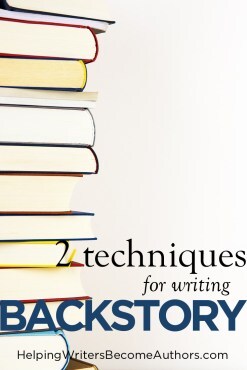 Backstory techniques are crucial to the success of any type of story. Whether you share all of your characters’ pertinent backstories or none, backstory still informs the entire story. What, when, and how to share backstory are important decisions for any writer. Making the right choices will determine not just whether or not your backstory works, but possibly even whether your entire story works.
Backstory techniques are crucial to the success of any type of story. Whether you share all of your characters’ pertinent backstories or none, backstory still informs the entire story. What, when, and how to share backstory are important decisions for any writer. Making the right choices will determine not just whether or not your backstory works, but possibly even whether your entire story works.
Today’s post is the second in a three-part series discussing five important techniques for sharing backstory. Last week, we talked about the advantages and disadvantages of using flashbacks and prologues to dramatize segments of your characters’ histories. This week, we’re going to talk about two possible approaches to your story’s timeline—and how to identify which might be best for your story, based on the depth and importance of its backstory.
As I mentioned last week, these posts were inspired by Amazon’s limited series The English, a neo-western about a recently bereaved Englishwoman who partners with a decommissioned Pawnee scout while on a mission of vengeance against the father of her child, whom she blames for her son’s death. Although the show has a lot going for it, its greatest weakness was its delivery of certain crucial backstory reveals. Who was the child’s father? Why does the woman—Cornelia Locke—blame him for her son’s death? Why aren’t they together?
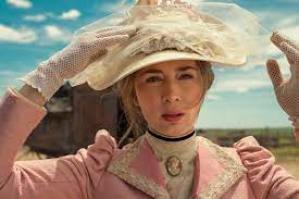
Backstory techniques are crucial in The English, since what happened in the past fuels the protagonist’s quest for vengeance.
Aside from sloppy misdirection that leads audiences to believe the father is another character entirely, the main problem is the choice to insert a lengthy flashback in the middle of the story. The flashback, in which the two main characters are barely present, takes up an entire episode (which means it requires a full sixth of the overall story) and grinds the momentum of the main story to a halt. Granted, it packs a wallop of a reveal, but due to its poor execution, it saps itself of potential power.
As discussed last week, the backstory techniques of prologue and flashback are usually best when what you want to share either needs to be foreshadowing (i.e., a prologue) or needs to be foreshadowed (i.e., a flashback). They are not usually the best choices when what you need to share requires a lengthy chunk of dramatization that interrupts the main story. If you feel your backstory is so momentous it requires more than a very small percentage of the story’s overall length to show, you may be better off exploring one of the remaining three techniques:
1. Open with the backstory as the logical starting point for a linear timeline, essentially turning the backstory into the main story.
2. Split the story into alternating timelines, in which the backstory is prominently woven in with the main plot in alternating scenes or chapters.
3. Reveal the backstory gradually as you go and primarily through dialogue between characters.
We will discuss the first two techniques today and the final (and usually best) technique next week.
When Backstory-as-Story Works BestA linear timeline is one in which the story is told chronologically, from beginning to end. Most stories utilize a linear timeline. Even those that include large sections of dramatized backstory, via prologue and flashback, are usually still considered linear. The choice to utilize a linear timeline in your story (as you are very likely already doing) does not necessitate opening with the backstory. We will discuss this approach more thoroughly next week.
However, a linear approach to backstory can be used when the author recognizes the story’s proposed backstory is, in fact, important and interesting enough to become the front story. In this instance, the story opens with what would otherwise have been a historical event in the character’s past, which allows readers to experience the unfolding of events in “real time,” right alongside the characters.
In some ways, this is similar to opening with a backstory prologue that dramatizes an important catalyst in the character’s past. However, in a linear approach, the story does not then jump ahead to the “main” story. It uses what might otherwise have been backstory as the jumping-off point for a chronological account that shares the character’s experiences from that moment on.
The Advantages: Linear timelines allow events to build into each other, creating a tight line of cause and effect. Momentum is allowed to gather, with no need to slow down or interrupt the plotline in order to fill in audiences on characters’ motivations or secrets. This, in itself, is a high-level skill, since there is nowhere to hide in a strictly linear story. In this type of story, if the main plot isn’t working, then the whole story isn’t working. (However, it’s worth noting that if the main plot is not working, trying to distract audiences from the problem by interjecting flashbacks won’t work either.)
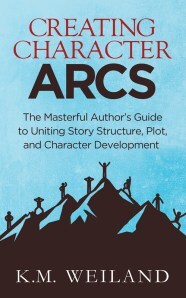
Creating Character Arcs (Amazon affiliate link)
When you begin with what might otherwise have been backstory, you allow readers a front-row seat to the entire unfolding of the story. They get to experience the characters’ full arcs, to experience the characters’ motivations viscerally, and to understand the context of every choice and action. Although less flashy than some of the other techniques, it’s hard to beat this one for full-on tension and power, when it’s done well.
The Disadvantages: The major disadvantage of beginning with your backstory is that you may rob your story of depth. When you lay everything out in the open for readers to see right from the beginning, the story can end up feeling too on-the-nose. Revealing your backstory in the beginning can also rob you of the opportunity to create suspense and intrigue via backstory hooks, foreshadowing, and secrets.
Opening in medias res (“in the middle” of events) is a popular technique exactly because it skips the backstory and gets right down into the most interesting dynamics within the story. If, as in The English, the most interesting dynamic has to do with the protagonist in a particular relationship or place, then opening with a backstory that does not feature that dynamic will fail to properly frame the story. It will not only slow down the opening, but also fail to foreshadow what is to come.
Tips: The major factor in deciding whether or not to tell your backstory as part of the main story will be whether or not the events in your story happen within a cohesive timeline. For instance, if the major backstory event happens when your protagonist is a child, while the main plot does not begin until after high school, you will not have enough pertinent events in between to fully dramatize. In this case, you’re better off using one of the other techniques.
A second factor is whether the events of the backstory are truly interesting enough to open your story. Your first chapter is your story’s Hook, which means its first job is to grab readers’ attention. If it cannot hook readers, it won’t matter how well it sets up what is to follow.
Finally, consider whether the events have more weight when told upfront, so readers are aware of their impact throughout, or if they actually have more weight when held in reserve for a big reveal.
Example: The English does not open with its backstory—which is the best choice in this instance. Its backstory (in which both main characters encounter the antagonist in separate traumatic moments) is removed from the main part of the story by over a dozen years. Although Pawnee scout Eli Whipp’s encounter occurs in the main setting of Wyoming, Cornelia’s backstory encounter takes place in her home in England.
Opening with the backstory here would have meant opening the story with events that do not properly frame the main plot—which focuses on a mission of revenge, the unlikely bond between an English lady and a Native American soldier, and the harrowing landscape of the American West.
In this story, much of the tension arises from the fact that Cornelia does not tell Eli about her past—her reasons for wanting to kill her child’s father, what happened to her child, or why she is willing to risk her life to hunt this man through a strange wilderness. Had these questions been answered upfront for audiences, they would not have shared Eli’s growing confusion, interest, and understanding for Cornelia.

The English rightly chooses not to open with its backstory, as its most important events are too far in the characters’ pasts.
When Alternating Timelines Work BestAn alternating timeline is one in which the story is split into two different stories—the backstory and the main story—which are both dramatized and equally interspersed throughout the story. This is a complicated approach that requires two structurally complete stories that twine around each other until they finally come together to mutually inform the Climax.
The Advantages: The main attraction of alternating timelines is that they allow you to fully dramatize an interesting backstory without losing any of the suspense or subtext, as you might if you began with the entire backstory. Alternating timelines can also bring a good deal of complexity to a story’s presentation, layering the events and perspectives of one timeline onto the other. They work best when the backstory is dense, featuring many reveals that can be dramatized at exactly the right moment, allowing readers to learn important backstory details that enhance understanding, irony, or subtext in the present-story timeline.
The Disadvantages: As with any complex technique, the more working pieces you’re dealing with, the more there is that can go wrong. The primary challenge of alternating timelines is that both timelines must be equally interesting to audiences. If readers like one timeline significantly better, then they may grow impatient with the other one.

Writing Your Story’s Theme (Amazon affiliate link)
Alternating timelines require from authors a sure sense of the story’s larger picture, not just chronologically, but also thematically. The best alternating-timeline stories are those that use the contrasting timelines not just to drive the plot, but to deepen the thematic exploration.
A final consideration should be the fact that alternating timelines can obviously double your story’s word count, which may be problematic for a number of reasons.
Tips: The only time you should ever consider an alternating timeline is when the backstory is just as momentous as the main story. Every scene in the backstory section must inform the main story timeline. If you find you are fleshing out backstory scenes just to make sure the number of scenes in your past timeline equals those in your present timeline, that could be a sign the backstory is not meaty enough to merit this technique.
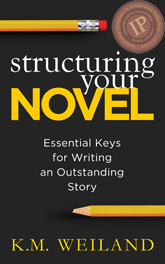
Structuring Your Novel (Amazon affiliate link)
Structurally, each timeline should present a full set of plot points that braid together to reach a single conclusion. The backstory timeline may not focus on events as much as the main timeline, but it should at least offer important information reveals that tie in with or influence the plot points in the main section. To the degree irony arises between the two contrasting timelines, the more subtext and interest you will create.
Ultimately, this is a style all its own, which should not be attempted unless you are quite sure this is the flavor and format you want for your story. If your only motivation for choosing alternating timelines is that you want to dramatize the backstory, you may be better off using one of the other, simpler techniques.
Example: The English does not use an alternating timeline—and that, too, is the best choice in this instance. Why? Because aside from the two important backstory moments (when the two main characters respectively encounter the antagonist), nothing that happens in the backstory is directly pertinent to the main plot. More than that, the larger backstory here could not have been told in the same style as the main story. Cornelia nursing her son back in England and Eli scouting for the U.S. Cavalry have nothing to do with Cornelia and Eli’s mutual dynamic which is central to the main story.

When choosing backstory techniques, the use of alternating timelines should only be used in stories in which the backstory timeline will fully complement the present-day timeline–which would not have been the case in a story such as The English.
***
So what backstory techniques should have been used in The English? When I first started writing these posts, I originally intended just a two-part series contrasting the specialized backstory techniques of prologue vs. flashback vs. backstory-as-story vs. alternating timelines. But I’ve decided to add a third and final part, discussing general backstory techniques within a linear timeline. This is the most widely used approach to backstory for the simple reason that it is the most utilitarian and effective.
So stay tuned: Next week, we will round out the series with a discussion of Backstory in a Linear Timeline.
Previous Posts in This Series:
Prologues vs. FlashbacksWordplayers, tell me your opinions! Have you ever tried the backstory techniques of backstory-as-story or alternating timelines? Tell me in the comments!Click the “Play” button to Listen to Audio Version (or subscribe to the Helping Writers Become Authors podcast in Apple Podcast or Amazon Music).
___
Love Helping Writers Become Authors? You can now become a patron. (Huge thanks to those of you who are already part of my Patreon family!)The post Backstory-as-Story vs. Alternating Timelines (Backstory Techniques, Pt. 2 of 3) appeared first on Helping Writers Become Authors.
April 17, 2023
Prologues vs. Flashbacks (Backstory Techniques, Pt. 1 of 3)
 If you want to rev up a group of passionate writers, just bring up the topic of backstory. As much as we love our stories, we often love our backstories even more. If plot offers a what and a how, backstory is often the why. It can provide both context and subtext, bringing depth, understanding, and subtle nuance to a character’s journey through the main story. Handled well, backstory techniques can elevate your entire story. Handled poorly, backstory can ruin the entire experience for your audience.
If you want to rev up a group of passionate writers, just bring up the topic of backstory. As much as we love our stories, we often love our backstories even more. If plot offers a what and a how, backstory is often the why. It can provide both context and subtext, bringing depth, understanding, and subtle nuance to a character’s journey through the main story. Handled well, backstory techniques can elevate your entire story. Handled poorly, backstory can ruin the entire experience for your audience.
I’ve written many posts about important considerations such as:
How to Discover Your Character’s BackstoryThe Right Time to Share BackstoryWhen to Avoid Backstory AltogetherWhat to Do When Your Backstory Becomes Your StoryWhat is the best way to interpolate backstory into the main plot? Today, I want to talk about specific backstory techniques you will need to choose between when sharing your characters’ histories with your audience. The goal should be to fully satisfy your audience’s curiosity without slowing down the momentum of the main plot. This can be easier said than done, and largely comes down to the right choice of one of five techniques: prologue, flashback, backstory-as-story, alternating timelines, or linear timeline. We will discuss the first two in today’s post, the second two in next week’s post, and the final (most common and utilitarian) practice in the third post.
This discussion was inspired by Amazon’s recent limited neo-western series The English, starring Emily Blunt, about an Englishwoman on a mission of revenge who becomes the unlikely travelling companion of a decommissioned Pawnee Cavalry Scout.

Backstory techniques are extremely important in The English, both because they influence the entire plot and because the methods used to share them with readers were not the best choice for the story’s overall pacing.
On the whole, I quite liked the show, particularly the relationship between the two leads. But one area in which I felt it faltered was its execution of backstory. The backstory reveal is a huge moment that changes everything in the plot, but both its timing and the chosen technique of a lengthy flashback (comprising an entire episode) muddied the story’s pacing and momentum. I will discuss what went wrong in the section below about flashbacks, as well as sharing how the other potential backstory techniques might have been better choices.
Needless to say, the entire post will be filled with SPOILERS for The English.
What Is a Complex Backstory?First, let us examine the differences between a complex backstory and a simple backstory. When the events of your characters’ pasts are incidental to the events of the main plot or the characters’ personal development in that plot, your story isn’t likely to require any particular technique to share it with readers. This is a simple backstory.
A complex backstory, on the other hand, is backstory that greatly impacts the events and development in the main plot. Indeed, as in The English, the backstory may be driving everything that happens in the main plot.
Complex backstories are often used in stories that feature one or more of the following:
Complicated Motivations: the characters’ reasons for pursuing their main plot goals are not straightforward or are born out of the characters’ inner conflict (e.g., in The English, Cornelia Locke seeks vengeance against the father of her dead child, whom she holds responsible for his death).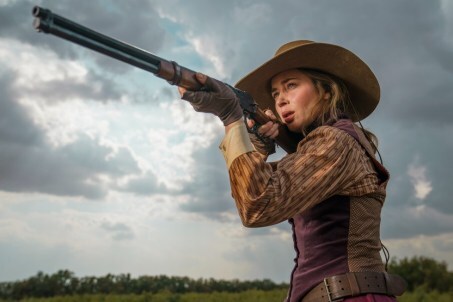
The backstory in The English revolves around the reasons the protagonist is seeking vengeance against her dead child’s father.
Secrets Characters Are Keeping From Each Other: characters are not sharing important information (usually about their motivations) with other characters (e.g., Cornelia keeps many secrets from Eli Whipp, her travelling companion, including the truth about her child’s father and the child’s manner of death)
Backstory can often be shared in the form of secrets from one character to another.
Secrets Character Is “Keeping” From Self: characters may not know their own pasts as well as they believe, either because they are deluding themselves and cannot face the truth, or because they are missing key pieces of information (e.g., characters may learn the truth about a dead parent or grandparent, changing their perspective on their own journeys)Secrets Author Is Keeping From Reader: characters know the truth of the past, but the author purposefully keeps the audience in the dark to allow for a reveal later on. This is the trickiest approach, since it can put audiences at a remove from characters’ development and sometimes even “played” by the author.In all cases, backstory information will be shared as either context or a reveal.
If the backstory is simply contextual, then it is presented as basic information readers need to know in order to understand what is going on. For example, The English casually explains Cornelia’s rank as a “lady” in England, as well as Eli’s service in the U.S. Cavalry. Neither bits of info are reveals; they are simply information necessary to build the story world.
On the other hand, if the backstory is used to create a reveal, then it must bear much much more weight within the main story. It becomes a pivot point. The very act and timing of its revelation changes the perception of the audience and/or the characters—preferably both. For example, The English saves up several important pieces of information, but none so shocking as the identity of Cornelia’s child’s father—whom audiences were led to believe was someone else.
When planning your backstory, a good rule of thumb is that complex backstories are best for simple stories; simple backstories are best for complex stories. If your main plot is complicated in its own right, then a complex backstory that requires much explanation and many reveals may not be the best choice. But if your main plot is relatively simple with a straight throughline, a complex backstory can add depth and nuance.
When Flashbacks Work BestBackstory and flashbacks are synonymous in some writers’ minds. The flashback is the technique of interjecting a dramatized scene from a character’s past into the main part of the story.
The Advantages: Flashbacks are visceral and immediate, allowing audiences to experience the backstory with just as much potency as any of the scenes in the main part of the story. They are also detailed, which ensures complicated events can be fully explored and explained.
The Disadvantages: Flashbacks necessarily stop the progression of the main part of the story. They require audiences to be patient while a new scene(s) is carefully fleshed out, sometimes with an entirely different or altered cast of characters.
Tips: Short flashbacks are usually best, especially if you’re introducing them late into the story with no foreshadowing of a time shift (such as you would have in a story with an alternating timeline, as we’ll discuss in next week’s post). However, if you do decide you want to include a lengthy flashback (of more than short scene), make sure it is dramatic enough to carry its own weight. The longer a flashback, the more dramatic it should be.
Avoid exposition; flashbacks should not be about explaining things to audiences, but only about providing answers to questions that have already been set up to hook their curiosity. Flashbacks need to introduce new information that turns the main plot. By nature, flashbacks pull audiences out of the main story, which means whatever you share in the flashback should be riveting enough to pull them right back in.
Example: The English shares its major backstory reveal in a lengthy flashback that comprises an entire episode (which, in this story, is an entire sixth of its overall length). In this instance, the flashback was arguably not the right choice. One of the main reasons for this is that the episode focuses primarily on the antagonist, rather than the protagonists. In this instance, the problem is compounded further by the fact that the antagonist was never introduced in the story up to this point. In fact, he had been barely acknowledged beyond a few mentions of his name and a vague indication that minor characters dislike him.
Because this flashback was poorly set up, it interrupts the pacing and momentum of the main story. It forces the audience to leave behind the story they have so far invested in (the relationship between the two leads) to spend a great deal of time with characters whom they neither know nor like. Had the antagonist been better set up, the flashback would have felt more important to the story, rather than coming as a bolt from the blue that audiences don’t really care about until after it’s over.
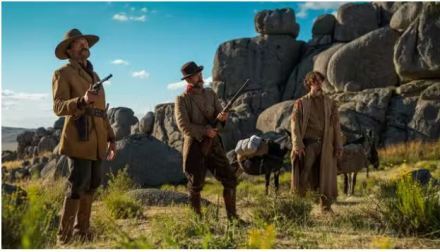
The English shares its backstory by telling the history of a previously unintroduced antagonist (played by Rafe Spall) in an episode than spans 1/6th of the story’s overall running time.
When Prologues Work BestPrologues can take many forms. Sometimes they might be a “flash forward” to show an event from later in the story. Other times, they are used as an atmospheric hook to set the tone and plant a quick bit of foreshadowing to be paid off later in the story. Most often, however, they are used as a sort of flashback in their own right, to show a glimpse into an important moment in the characters’ backstory before the audience flips ahead to the main plot.
The Advantages: Thanks to their positioning at the very beginning of the story, prologues set the stage. This means they never need to be foreshadowed or set up, as do flashbacks; they are the set up. If the prologue is effective (i.e, more than just an info dump), it can frame the story by hinting at what important revelation the entire story is building toward. Prologues are also relatively “short, quick, and dirty.” They let authors get the backstory out of the way, so they then can then pursue the main plot uninterrupted.
The Disadvantages: Like flashbacks, prologues live apart from the main narrative and can therefore create a bit of a “bump” for readers as they transition from past to present within the story. Used well prologues can create subtext; used poorly, they can destroy opportunities for tasty subtext that might otherwise have existed within the story. The main challenge they create is that they force readers to begin a story twice—which means you must hook them twice.
Tips: If you decide to utilize a prologue to share important backstory information, do it in a way that creates questions rather than offering all the answers upfront. If you’re giving readers a prologue, this means whatever happens in this scene must be important to pulling them into the story to follow. The prologue should create momentum, drawing readers into the need to know how the consequences of this backstory moment will play out.
Example: The English utilizes a very brief prologue, of sorts, in which protagonist Cornelia voices over a scene of remembrance about her time in Nebraska with Eli Whipp. By itself, the prologue is effective, since it teases what is to come, sets up the general vibe of the story, and pulls audiences into the narrative. However, in light of the fact that the backstory flashback halfway through the show ends up completely altering the context for what is initially set up, the prologue could have been better utilized.
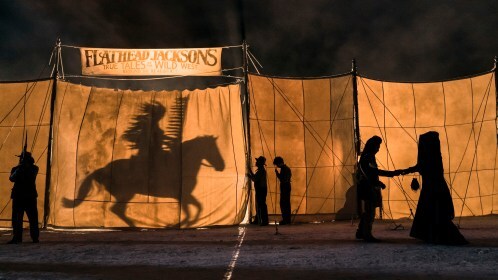
The English opens with a prologue that is both a bit of a flash forward and flashback, as an older Cornelia speaks of memories.
***
Flashbacks and prologues are highly specialized techniques and will not be the right choices for every story. However, when used at exactly the right moment, they can allow an author to skillfully shape the audience’s experience. If flashbacks and prologues are not the right choice for your story, then don’t worry! Next week, we will discuss backstory techniques for stories that utilize backstory-as-story and alternating timelines.
Wordplayers, tell me your opinions! What backstory techniques have you used in your stories? Tell me in the comments!Click the “Play” button to Listen to Audio Version (or subscribe to the Helping Writers Become Authors podcast in Apple Podcast or Amazon Music).
___
Love Helping Writers Become Authors? You can now become a patron. (Huge thanks to those of you who are already part of my Patreon family!)The post Prologues vs. Flashbacks (Backstory Techniques, Pt. 1 of 3) appeared first on Helping Writers Become Authors.
April 10, 2023
Have You Chosen the Right POV Character for Your Story?
 Note: After all the excitement of launching my new book Writing Archetypal Character Arcs last month, I’m giving myself a little break this week from the usual post and podcast. Instead, I am sharing a fast tip that I hope you will enjoy and find useful! I will be back next week with a brand new post about the pros and cons of prologues vs. flashbacks when writing stories with complex backstories.
Note: After all the excitement of launching my new book Writing Archetypal Character Arcs last month, I’m giving myself a little break this week from the usual post and podcast. Instead, I am sharing a fast tip that I hope you will enjoy and find useful! I will be back next week with a brand new post about the pros and cons of prologues vs. flashbacks when writing stories with complex backstories.
Also, if you didn’t know, I have been posting lots of goodies on Instagram lately, including a weekly Q&A vid (which you can also watch on YouTube). I hope you’ll come visit me!
***
One of the single greatest decisions authors make for their stories is selecting the right POV character for the story. And yet this is often a decision we make in a split second. Usually, the answer seems to be staring us in the face right from the beginning. The main POV should go to the character who inspired the story to begin with, the character we love the most—that’s the character who should get top billing, right?
Ninety percent of the time, yes. However, it’s wise to double-check yourself by taking at least one look beyond the obvious choice. You may look at your options and decide, after all, that your first choice was indeed your best choice. But in opening your narration prospects just a bit, you may also find some surprising opportunities for your story.
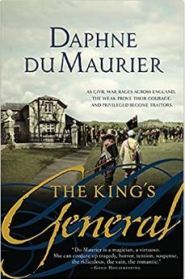
The King’s General by Daphne du Maurier (affiliate link)
For example, Daphne du Maurier’s swashbuckling historical The King’s General is based on the life of Sir Richard Grenville, a prominent and colorful character in the English Civil War. At first glance, he would seem to be the prime choice to narrate his own story. Du Maurier, however, bypassed Grenville as both the narrator and, as a result, the main character. She chose instead to entrust her story to a surprising source: a fictional paraplegic woman named Honor Harris whose life frequently intersects with Grenville’s.
A cursory examination of this choice might make us question du Maurier. After all, she not only chose a bit player to star, she also chose someone who, at first glance, might seem limited in participating in much of the physical action.
However, a closer look proves du Maurier’s choice was that of a seasoned storyteller, who knew how to achieve just the right framing for her story and just the right distance from her sometimes unlikable historical hero. She chose a unique and compelling point of view that allowed her to pace and shade the story to her own specifications.
Not every story will benefit from the choice of an unconventional narrator, but this is a reminder that it’s worth taking a look at all your options before choosing your story’s main character.
Wordplayers, tell me your opinions! Who did you choose as the main POV character for your latest story? Tell me in the comments!The post Have You Chosen the Right POV Character for Your Story? appeared first on Helping Writers Become Authors.
April 3, 2023
Writing Archetypal Character Arcs Launch Day Winner Announced!
First, I want to take a moment to thank you all for your support and enthusiasm for my new book Writing Archetypal Character Arcs.
Thank you for making the launch a success! It was one of the best pre-launches and launches I’ve ever had, and I am so grateful to all of you for making it happen!
It’s been wonderful to hear from those of you who are already digging into the book and discovering the transformative power of archetypal story forms! I hope the book will encourage and inspire you in the crafting of many stories to come. Here’s to Wordplayers everywhere!
And now the news you’ve all been waiting for. The winner of the Freewrite Typewriter is… Katie Baldwin.
Thank you all once again for joining me for the celebration of the book’s launch! And if this is your first time hearing about it, I’m sorry you missed the opportunity to join the giveaway. But the good news is you can still grab the book!
Where to Buy the Book
Writing Archetypal Character Arcs (affiliate link)
You can purchase the book at the following links:
Amazon USA (affiliate link)
(Audiobook version coming soon!)
(If you don’t have a Kindle but want to take advantage of the cheaper e-book option, you can read Kindle books off your computer, iPhone or iPad, or Android, using their respective Kindle apps.)
Book DescriptionThe Six Transformational Character Arcs of the Human LifeReady to take your story’s character arcs and themes to the next level? This latest book from veteran writing teacher and story theorist K.M. Weiland ventures far beyond the popular and pervasive Hero’s Journey to explore six important archetypal character arcs, representing key moments of initiation in the human experience:
The MaidenThe HeroThe QueenThe KingThe CroneThe MageFound in every genre from fantasy to drama to romance to adventure, these transformational stories are the secret of powerhouse fiction—as shown through a wide variety of real-story examples throughout the book.
Writing Archetypal Character Arcs will teach you:
The archetypal beats for each of the six journeysWhich archetypes are right for your particular storyThe best way to use archetypes in a seriesHow to choose the right archetypes for supporting charactersHow to use archetypes to identify your story’s themeYou will also learn how to deepen your stories by implementing shadow archetypes (the negative sides of each positive archetype), resting or “flat” archetypes (the fixed stage between each of the main arcs), and archetypal antagonists (the epic antagonistic forces that oppose each of the positive archetypes in their journeys). The Hero’s Journey is just the beginning. Learning about archetypal character arcs will change the way you view stories—and life—forever.
I’ll be taking a bit of a break this week and next, but I can’t wait to see you on the other side and hear about all your archetypal adventures.
Happy writing!

The post Writing Archetypal Character Arcs Launch Day Winner Announced! appeared first on Helping Writers Become Authors.
March 30, 2023
Launch Day for Writing Archetypal Character Arcs (Win a Freewrite!)
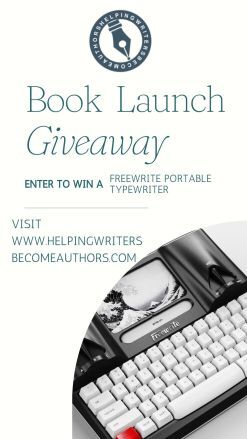 Welcome to Launch Day! Today, at long last, I get to officially share my newest book on the craft of writing and storytelling. For me personally, Writing Archetypal Character Arcs: The Hero’s Journey and Beyond has been quite literally an archetypal journey. I am so excited to finally and officially share it with all of you!
Welcome to Launch Day! Today, at long last, I get to officially share my newest book on the craft of writing and storytelling. For me personally, Writing Archetypal Character Arcs: The Hero’s Journey and Beyond has been quite literally an archetypal journey. I am so excited to finally and officially share it with all of you!
You can purchase the book at the following links:
Amazon USA (affiliate link)
(Audiobook coming later this year!)
If you don’t have a Kindle but want to take advantage of the cheaper e-book option, you can read Kindle books off your computer, iPhone or iPad, or Android, using their respective Kindle apps.

This book dives deep into the possibilities for using all the power of “mythic beat sheets” in your own stories. Whether you’re writing fantasy or mystery or romance or contemporary drama, your stories will benefit from an understanding of how archetypal characters and archetypal journeys inform the life cycle of the human experience.
The first and most important part of the book goes deep with six foundational and sequential archetypal character arcs:
1. The Maiden – Coming of Age
2. The Hero – Slaying the Dragon
3. The Queen – Defending the Kingdom
4. The King – Becoming the Sacrifice
5. The Crone – Facing Down Death
6. The Mage – Surrendering Control

The book then explores twelve shadow archetypes—two for each of the main arcs: the Damsel/Vixen, the Coward/Bully, the Snow Queen/Sorceress, the Puppet/Tyrant, the Hermit/Witch, and the Miser/Sorcerer.
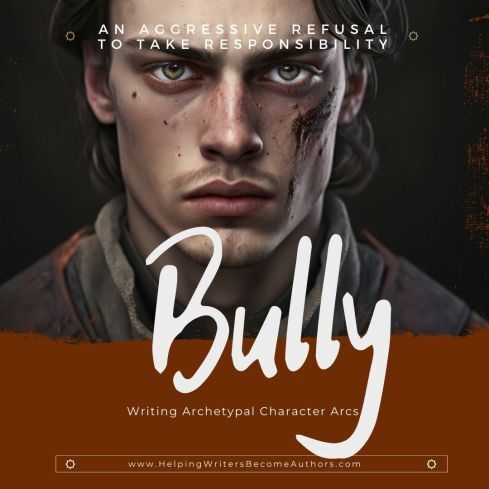
It also talks about the six “flat” or resting archetypes that live in the calm between transformative arcs: the Child, the Lover, the Parent, the Ruler, the Elder, and the Mentor.

And it finishes with a discussion of the twelve symbolic archetypal antagonists that oppose characters in their attempts to complete their mythic journeys: Authority and Predator, Dragon and Sick King, Invader and Empty Throne, Rebel and Cataclysm, Tempter and Death Blight, and Weakness of Humankind and Evil.
I talked about my own deeply personal journey with these archetypes in a post earlier this week, and you can read the official back cover blurb here:
The Six Transformational Character Arcs of the Human LifeReady to take your story’s character arcs and themes to the next level? This latest book from veteran writing teacher and story theorist K.M. Weiland ventures far beyond the popular and pervasive Hero’s Journey to explore six important archetypal character arcs, representing key moments of initiation in the human experience:
The MaidenThe HeroThe QueenThe KingThe CroneThe MageFound in every genre from fantasy to drama to romance to adventure, these transformational stories are the secret of powerhouse fiction—as shown through a wide variety of real-story examples throughout the book.
Writing Archetypal Character Arcs will teach you:
The archetypal beats for each of the six journeysWhich archetypes are right for your particular storyThe best way to use archetypes in a seriesHow to choose the right archetypes for supporting charactersHow to use archetypes to identify your story’s themeYou will also learn how to deepen your stories by implementing shadow archetypes (the negative sides of each positive archetype), resting or “flat” archetypes (the fixed stage between each of the main arcs), and archetypal antagonists (the epic antagonistic forces that oppose each of the positive archetypes in their journeys). The Hero’s Journey is just the beginning. Learning about archetypal character arcs will change the way you view stories—and life—forever.
Find the Tools to Write Stories Readers Will Never ForgetEnter to Win the Writing Archetypal Character Arcs Launch PrizeTo celebrate the launch of Writing Archetypal Character Arcs, I am giving away a Freewrite! The winner will receive their choice of either the Gen3 Smart Typewriter or the Traveler (value up to $649).

Description of the Freewrite Smart Typewriter and Traveler:
“The Smart Typewriter is a dedicated drafting device for anyone who writes without the distraction—or temptation—of browsers, email, or notifications. Get in writing flow and develop more prolific writing sessions by separating the drafting and editing processes. When it is time to edit, your drafts wirelessly sync to the cloud for export into your software of choice. Push your productivity forward and tap into writing joy!” (Read more about the Typewriter here and the Traveler here.)

Winners will be announced Monday, April 3rd. Enter below! (Note: no purchase is necessary to enter.)
Good luck to everyone in the drawing, have fun, and thank you for helping me celebrate the launch of Writing Archetypal Character Arcs!
The post Launch Day for Writing Archetypal Character Arcs (Win a Freewrite!) appeared first on Helping Writers Become Authors.
March 27, 2023
How Archetypes Changed My Life and My Writing
 Story and life are inextricably linked. To write better stories, we study life. And to live better lives, we study stories.
Story and life are inextricably linked. To write better stories, we study life. And to live better lives, we study stories.
There are many obvious reasons why this is so. Stories, after all, are meant to be relatively accurate reflections of life. However, the more I study story theory, the deeper the rabbit hole seems to go. One of the most exciting discoveries down that hole has been archetype.
All of story reflects an archetype, and all archetypes contain stories. When we talk about story structure or genre or character arc or even trope, we are contributing to a larger conversation about archetype.
By definition, an archetype may be categorized in one of three ways:
1. A typical specimen.
2. An original model.
3. A universal or recurring symbol.
All three are useful for understanding story. So, no surprise, all are also useful for understanding life.

Writing Archetypal Character Arcs (affiliate link)
In a few days, on March 30th, I will be officially launching what has been the most personally important book I have ever written, Writing Archetypal Character Arcs. The book discusses the cycle of six initiatory character arcs that can be recognized in the human life—from the coming-of-age of the Maiden to the adventurous individuation of the Hero to the leadership of the Queen to the sacrifice of the King to the acceptance of the Crone to the final wisdom of the Mage.
It goes much deeper than just that, diving into twelve “shadow” archetypes that create inner obstacles within each transformative arc. It also talks about the importance of the “resting” archetypes that live between each transformative period. And it closes out with a look at the archetypal antagonists that grow with us throughout our life journeys.
It digs into why the Hero’s Journey is such an important archetypal arc, but also offers a more rounded view of mythic stories by exploring a fuller range of the human experience than just this one youthful masculine arc.
I have grown multitudes in the writing of this book, and it is a book I believe will continue to teach me as I progress through my own life arcs.
I know many of you have already grabbed the e-book during its (ongoing) early access here on my site, for which I thank you! You’ve made this far and away the most successful soft launch I’ve ever had. I’ve appreciated so much hearing from so many of you who have already dived into the book and found it powerful.
On Thursday, the book will officially launch, complete with wide release to major e-book sellers and the paperback on Amazon, as well as a super-fun giveaway here on my site! But, first, I wanted to take a moment to tell you not just about the book, but about how archetypes have changed my life. (Plus, if you scroll to the bottom, you’ll discover a surprise giveaway of a signed copy of the paperback! The winner will be announced before the launch.)
My Journey With Archetypes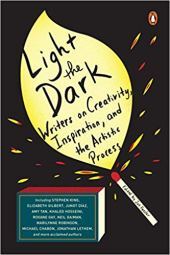
Light the Dark: Writers on Creativity, Inspiration, and the Artistic Process (affiliate link)
I have, of course, always been aware of archetypes. I have always derived meaning from story, not just as stories but as Story—thanks to the resonant power a good story can impart simply by coming into contact with someone. I paraphrase from Jonathan Letham’s essay “Letting the Leopards In” in the anthology Light the Dark.
Good writing does not make you feel as if you are reading it for the first time, but rather as if you have known it all along.
When “good writing” strikes its steel upon the flint of archetype, there is a sudden unity of truth between author and reader. It is what Jean Shinoda Bolen described when she wrote:
I had a sense of experiencing something beyond ordinary reality, something numinous—which is a characteristic of an archetypal experience.
At a time, a few years ago, of existential crisis within my own life, when my faith in something greater had been shaken even to the point of doubting there was “anything” to believe in, the question I kept returning to was: “What about the stories?” I knew, deep within myself, that the magic and the meaning I had always experienced through stories, and the patterns found in story form itself, had to be pointing to some bigger.

Walking on Water by Madeleine L’Engle (affiliate link)
The deeper essence and awareness of archetype came to me on the wings of Walking on Water, Madeleine L’Engle’s gently ferocious ode to the power of art, to its ability to create what Carl Jung calls “cosmos out of chaos.” I highlighted and scribbled all over this book, writing what would become the first scrap of my own book Writing Archetypal Character Arcs, which I’ll excerpt here:
Archetypal stories are stories that transcend themselves. Archetypes speak to something larger. They are archetypal exactly because they are too large. They are larger than life. They are impossible—but ring with probability. They utilize a seeming representation of the finite as a mirror through which to glimpse infinitude.
Despite their almost numinous quality, archetypes are a very real force in our practical world. Think of it this way: all the things we imagine actually exist. Aliens. Vampires. Dragons. Fairies. All the memories of our actual reality also exist—in real time—in the same way. Regardless whether these things can be proven as corporeal, they still exist within the human experience and impact it. The deeper the shared belief, the deeper and more meaningful the archetype becomes.
This “archetypal experience” changed everything for me. I knew immediately I wanted to write about archetypes, but something within me understood this was bigger than just one blog post. I would need time to walk my own path, to see where it led, and ultimately to experience some of these archetypes for myself.
Exploring the Feminine ArcsEven though I knew quite early on that I wanted to explore the power of archetypal storytelling, I didn’t yet know what I even meant by that. I knew the personal inner transformation I was already exploring within myself was about much more than just the mythic journey writers are usually pointed toward. The Hero’s Journey, however important and wonderful in its own right, is only one tiny scrap of the bigger picture.
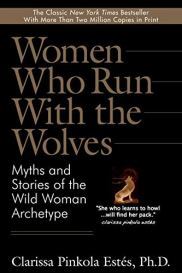
Women Who Run With the Wolves by Clarissa Pinkola Estes (affiliate link)
For me, it turned out that healing my relationship with my own wounded femininity and womanhood, digging up and rooting out some of the deeply internalized misogyny from my culture and subculture, was the first doorway to a world wider than I ever anticipated. When someone gifted me Clarissa Pinkola Estes’s Women Who Run With the Wolves, another archetypal experience exploded within me, and I began to explore the world through not just through the masculine lens I had always adopted but through the deeply vibrant, colorful, and healing perspective of the feminine.
Later, I would read Kim Hudson’s magnum opus The Virgin’s Promise, in which she explores the concept of a feminine partner arc to the well-known Hero’s Journey. Although she posits this arc as an alternative to the Hero—as a coming-of-age arc to be taken instead of the Hero’s Journey—I saw the two arcs as sequential. I knew the Hero Arc needed to be taken within my own life, but now I could also see how the Hero Arc could not, in fact, be undertaken properly unless this “younger” archetype (what I would come to call the Maiden) preceded it.

The Virgin’s Promise by Kim Hudson (affiliate link)
I went on to study Joseph Campbell’s seminal The Hero With a Thousand Faces, Robert Moore and Douglas Gillette’s King, Warrior, Magician, Lover, and Carol S. Pearson’s Awakening the Heroes Within, among many others. My mind was blown. I dug deeper still and realized the classic Three Acts of story structure itself reveal a full lifetime’s worth of transformative journeys. It turned out the Maiden and the Hero were just the First Act.
Exploring the Older ArcsIf the feminine archetypes have been lost in the shadow of the youthful Hero’s spotlight, so too have the older archetypes—the mature relational archetypes of the Queen and the King and the elder archetypes of the Crone and the Mage.
The Crone and the Mage, in particular, fascinated me. After all, story theory tells us the ending is in the beginning. Stories come full circle; it is their nature and their pattern. The early arcs of Maiden and Hero, however thrilling and prevalent, only gain context in view of their ultimate ending.
It became clear to me that these six particular archetypes marked crucial initiatory experiences within the human life. If humanity—or at least certain cultures—were struggling to provide their young with authentic initiatory experiences, then might it not be because relatively few initiated elders existed to catalyze those experiences?
Although the Queen and the King are both important for teaching and guiding the younger archetypes, it is the deep wisdom of the Crone and the Mage who complete the circle by coming to terms with the larger meanings of life itself. They pass the torch on to the young, through their spoken wisdom but perhaps even more crucially by taking their own final archetypal journeys side by side with the Maiden and the Hero.
Once again, I could see how each of these archetypes lined up so perfectly with the important beats of story structure itself. Planted deep within every story is the seed of the entire cycle of life arcs. For example, I could see how, even though I was chronologically at a stage in my own life of “cleaning up” my Maiden Arc and embarking on my Hero Arc, I was also going through a Crone “period,” a Third Plot Point exploration of death/rebirth, approaching the ending of one identity and the beginning of another.
Using Archetypes in One’s WritingI started exploring these archetypal arcs within my own writing. I started playing around with the arcs in my own stories, exploring what they might look like, leaning into what felt right, learning about them from the inside out.
At the time I was outlining a sequel. For the most part, the first book had taken the classic Hero Arc approach. I knew I couldn’t just repeat that same arc in the sequel, so I asked myself, “What happens after the happily ever after?” I looked to the next sequential archetype, the Queen, and started exploring what comes after the Hero Arc. From there, the mythic journeys for all these archetypes came pouring through me. I stopped writing my novel for a time and went right on exploring the full expression for all six archetypes.
From there, I started investigating even more nuanced archetypes: the shadow archetypes, the “flat” or unchanging archetypes, and the deeply symbolic archetypal antagonists for each of the six main life arcs. Suddenly, I could see these archetypes everywhere—in books, in movies, even in commercials, and of course in my own life and the lives of people around me.
Using Archetypes in One’s LifeI don’t think anyone needs to be told how to use archetypes in life. By their very nature, archetypes come loaded with all the personal revelations one needs. For me, one of the most powerful tools this system of “life arcs” gave me was the ability to examine my own life chronologically and to recognize which transformative arcs I may have already finished, which archetype I was currently working with, and which transformative arcs I may yet be fortunate (and hopefully courageous!) enough to take.
Seeing one’s life through the lens of archetypes provides context and direction. The archetypes provide us the initiatory experiences we need in each new chapter of our lives. The archetypes themselves can offer guidance even when these same archetypes may not be embodied by other people in our own lives. Indeed, the archetypes can help us grow, eventually, into the embodied elders our world desperately needs.
The more clearly we see and embody archetypes within our own lives, the more intuitive our ability to write stories (of all genres) that resonate powerfully with readers. Likewise, the more truly archetypal stories we are able to read or watch, the more gracefully we will be able to navigate through our own triumphs and travails.
The Book: Writing Archetypal Character ArcsAnd so I invite you to join me on this epic journey of writing not just better books and films, but also in writing our own life stories with intentionality and appreciation. Below is a description of Writing Archetypal Character Arcs, the book that has been both my companion and my guide during one of the most unforgettable decades of my life.
You can purchase the e-book (epub) right now on my site. Stay tuned for the official launch, happening in just a few days on March 30th. This will be when the paperback releases and when the e-book goes life on major platforms such as Amazon, Apple Books, and more. I will also be celebrating with a big prize giveaway, so even if you’ve already purchased the book, stop back in on Thursday for a chance to win!
In the meantime, scroll to the bottom to enter the drawing for a signed copy of the paperback. The winner will be chosen on the 29th.
Thank you all for co-writing with me this story that is our lives. Happy writing!
The Six Transformational Character Arcs of the Human Life

Writing Archetypal Character Arcs (affiliate link)
Ready to take your story’s character arcs and themes to the next level? This latest book from veteran writing teacher and story theorist K.M. Weiland ventures far beyond the popular and pervasive Hero’s Journey to explore six important archetypal character arcs, representing key moments of initiation in the human experience:
The MaidenThe HeroThe QueenThe KingThe CroneThe MageFound in every genre from fantasy to drama to romance to adventure, these transformational stories are the secret of powerhouse fiction—as shown through a wide variety of real-story examples throughout the book.
Writing Archetypal Character Arcs will teach you:
The archetypal beats for each of the six journeysWhich archetypes are right for your particular storyThe best way to use archetypes in a seriesHow to choose the right archetypes for supporting charactersHow to use archetypes to identify your story’s themeYou will also learn how to deepen your stories by implementing shadow archetypes (the negative sides of each positive archetype), resting or “flat” archetypes (the fixed stage between each of the main arcs), and archetypal antagonists (the epic antagonistic forces that oppose each of the positive archetypes in their journeys). The Hero’s Journey is just the beginning. Learning about archetypal character arcs will change the way you view stories—and life—forever.
Find the Tools to Write Stories Readers Will Never Forget
Wordplayers, tell me your opinions! Have you ever explored using archetypes in your stories—or in your life? Tell me in the comments!Click the “Play” button to Listen to Audio Version (or subscribe to the Helping Writers Become Authors podcast in Apple Podcast or Amazon Music).
___
Love Helping Writers Become Authors? You can now become a patron. (Huge thanks to those of you who are already part of my Patreon family!)The post How Archetypes Changed My Life and My Writing appeared first on Helping Writers Become Authors.
March 20, 2023
Here Are Two Ways to Write Organic Themes
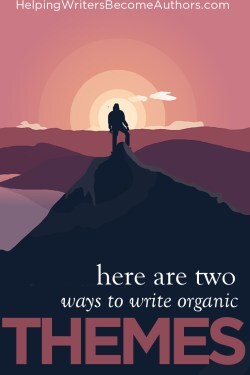 Organic themes are symbiotic with their stories’ plots. This is because when everything is working well in a story, plot and theme are two halves of a whole, each one “proving” the other. When plot and theme are not working together, that’s a sure sign your story is in trouble.
Organic themes are symbiotic with their stories’ plots. This is because when everything is working well in a story, plot and theme are two halves of a whole, each one “proving” the other. When plot and theme are not working together, that’s a sure sign your story is in trouble.
Theme can be a tricky storytelling technique. Plot is often easier to grasp; we can see it, after all. Theme, meanwhile, still carries around something of a mystique. And yet when it’s not working, oh boy, is it obvious.
I’ve written at length, in my book Writing Your Story’s Theme and elsewhere, about the necessary cooperation of the “Big Three”—plot, character, and theme—about how one generates the others. Basically, if your plot and character arc are functioning properly, then you can be sure a solid theme is also emerging. By the same token, if your story is successfully “proving” a strong thematic principle, then your plot structure and character arc beats will also be convincing to readers.

Writing Your Story’s Theme (Amazon affiliate link)
Today, I want to talk again about how organic theme arises from plot (and vice versa) and specifically how to recognize five important elements of an organic theme. This post was inspired by a misbegotten viewing experience with a 1995 HBO movie you’ve probably (and fortunately) never heard of. In Pursuit of Honor, starring Don Johnson, is supposedly about the final days of the U.S. Cavalry. Set in the 1930s, the Cavalry receives word that tanks are now the ride of the future and that their horses must all be destroyed. A renegade squad decides to save the horses with a desperate ride across the U.S., all the way from Mexico to Canada.
Pretty heroic, right? It’s also more than a little far-fetched, especially in light of the fact that nothing like this ever happened (that, in fact, many of the Cavalry horses ended up, ironically, as movie horses). However, the far-fetched non-reality of the premise isn’t necessarily the problem. Certainly many a better story has been told on many a stupider premise. But particularly because this story is trying to sell viewers on a far-fetched premise, its burden of proving its verisimilitude becomes all the more important. Basic story-world details aside, nowhere is verisimilitude more important than in the realism of plot and theme.
The shortest explanation for the responsibility of any story’s plot and theme combo is simply: make it feel real. More specifically, you must make the characters’ experiences (plot) and emotional motives and responses (theme) feel real. If you can do that, you can go so far as to tell a crazy cooked-up story about a Spanish general-turned-gladiator trying to take over the Roman empire (that’s Gladiator if you couldn’t tell). Nobody will care that the story is hooey.

The lack of strict historical realism doesn’t matter in Gladiator thanks to the strong realism of its organic themes.
On the other hand if the harmony of your plot and theme fail, what you might end up doing is taking beloved franchise characters and turning them into grotesque caricatures of themselves, completely sapping audiences’ suspension of disbelief and draining all heart and soul from the story (and that’s my take on Thor: Love and Thunder, if you couldn’t tell).

Phoning in any one of character, plot, or theme is a sure recipe for undermining all three—though it’s arguable that any of them work in Thor: Love and Thunder.
Today, because In Pursuit of Honor is fresh on my mind, I want to talk about its missed opportunities for elevating itself with organic themes. I’m going to contrast it with one of my all-time favorite classic westerns, John Sturges’s The Magnificent Seven, because I feel the two stories share similar thematic potential.
>>Click here to read a structural breakdown of The Magnificent Seven.
Two Ways to Write Organic Themes
Creating Character Arcs (Amazon affiliate link)
First of all, what are these “two ways to write organic themes”? Simply this: either theme must arise from plot, or plot must arise from theme.
Character is also vital, as the third member of the Big Three, but it lives in between plot and theme. Although you can certainly focus most of your attention on character arc in order to generate both cohesive plot and theme, plot and theme together will also generate all the opportunities you need for a strong character arc. (I have written specifically about character arc’s relationship to generating theme here.)
Theme From Plot
Structuring Your Novel (Amazon affiliate link)
Organic themes arise when the mechanics of the plot are well structured and well explored. If you thoroughly and honestly follow your character through the events generated by your plot conflict, certain themes will inevitably emerge. When those themes are then honed and emphasized, what results is a powerful sense of cohesion between the two.
Plot From ThemeYou can, of course, start with theme if you prefer. The trick here is to take an abstract idea (explorations of Puberty or Grief or Trust, for example) and use it to generate only plot events that develop the characters’ relationships to this idea.
If, however, you’re writing a story in which the theme has nothing to do with the plot and/or the plot is not exploring or commenting upon the theme, then you know you’re missing out on organic themes for your story.
4 Must-Have Elements of a Theme That WorksLet’s examine four elements that prove a theme is working within your story. And by “working,” I mean more than the theme simply acting in cohesion with the plot. I mean that the plot is generating events that force the characters to grapple with the questions and the consequences of the theme.
1. What Is Your Story About? No, What Is It Really About?Your initial answer to this question might be that your story is about a mutiny on a ship or the death of a child or a romance after a cancer scare. That’s good enough for a first answer. But now ask again: “What is your story really about?”
What your story is really about will be something deeper than just the obvious plot action. For example, the mutiny story might really be about the atrocities of the 18th-century naval system or it might be about power vacuums or it might be a great big metaphor for claustrophobia. Regardless, zoom out and look at the big picture. Within any functional plot idea, there is the potential for a deeply wrought exploration of theme.
How to Create Organic Themes: For example, while The Magnificent Seven‘s simple plot is about a ragtag bunch of gunfighters hiring on to help a farming village chase off bandits, its theme is much deeper. Underneath all the gunfire, it is a story about the end of an era: the last of the gunfighters. This is subtly evident throughout the story at every turn and is underlined in the closing lines, when one gunfighter says to the other, “Only the farmers have won. We never win.” The film closes on two survivors once more turning their backs on community and riding away into a future that has no place for them.

The 1960 western The Magnificent Seven remains a classic thanks to a laser-focused understanding of its own organic themes.
How Not to Create Organic Themes: In Pursuit of Honor is also a story about the end of an era. It clearly sets itself up as a story about the end of a more “honorable” way of making war, in contrast to the mechanized horrors yet to come in the impending Second World War. The entire plot focuses on “one last ride,” as the rogue soldiers race across the American frontier, much as did their pioneer forefathers only a half a century earlier, in a desperate gambit to save their horses. As you can see, even in this far-fetched premise, the theme is there. It is merely waiting for a craftsman to whittle it out of the raw wood and bring it forth into a realized plot. Unfortunately, that is not what happened in this film.
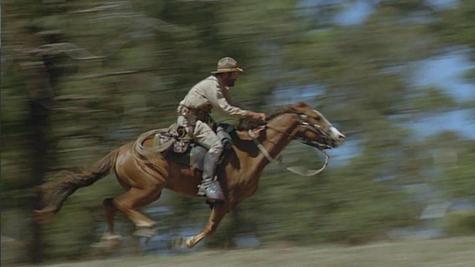
Although the 1995 HBO movie In Pursuit of Honor offered a premise with certain inherent themes, it’s poor development of plot and character failed to realize them.
2. Events Create Theme, But by Themselves Are Not ThemeHere’s an important riddle of the writing profession: plot can create theme, but it is not theme. Simply put, you can trot your story through any number of events, but by themselves these events will not show audiences what your story is about on a deeper level.
This deep level of theme is accessed when you show how your characters are affected by the events of your theme. Events are important, but consequences are more important. When events cause characters to feel something, audiences will believe those events actually possess any meaning. Do not neglect the reaction phase of your story’s scene structure; this is where your theme’s gravitas will find the necessary space to unfold.
How to Create Organic Themes: Although categorically an action film, The Magnificent Seven spends most of its running time on slower scenes in which the gunfighters interact with the villagers. This is important because it allows the story to contrast the comparatively peaceful and loving family lives of the villagers with the lonely and sometimes brutal lives of the gunfighters. Even more importantly, it allows the story to show what these interactions mean to the gunfighters. Each character has his own subplot, but perhaps the most moving is Charles Bronson bonding with three youngsters, which forces him to face his own submerged past as a half-Mexican, half-Irish boy who was caught “in the middle.”
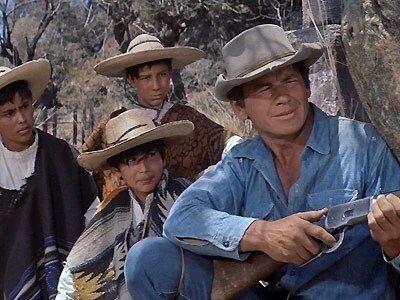
Even though The Magnificent Seven offers plenty of genre-appropriate action, it transcends itself by focusing most of its weight and running time on thematically important character relationships.
How Not to Create Organic Themes: In Pursuit of Honor creates plot events that put its characters through the wringer. These men desert their outfit and herd horses across the full length of the American frontier, all while being chased by both the new Armored divisions and their fellow Cavalrymen. But none of it ever feels weighty because the effects of these actions are never fully explored. Unlike the pioneers who had to fight their way through weather and over mountains, holding out for the next water hole, and praying to beat winter, these Cavalrymen barely grow beards, never go hungry, somehow skip the Rockies altogether, and seem to make the trip all before spring ends.
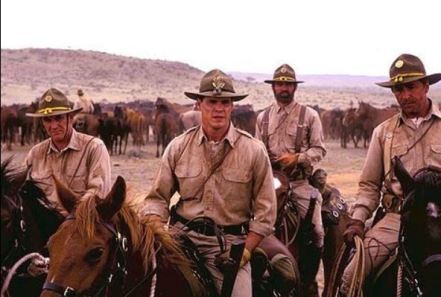
In Pursuit of Honor fills its running time with exciting action scenes, all of which fall flat because the characters are too thinly sketched to make audiences care about them.
3. Theme Means Nothing Without Character ChangeE.M. Forster famously commented upon plot and theme when he said:
“The king died, and then the queen died” is a story. “The king died, and then the queen died of grief” is a plot.
Fundamentally, what he is talking about here is the need for story events to not just impact characters but to change them. This is the measure of whether a story’s plot is progressing. If there is no change, then there is no progression—and no point. This is why theme is inherently linked to character arc. If the character is arcing, then theme is emerging. Although the opposite is also true, theme cannot emerge if the character is not responding to the plot events in some deep way.
This means more than simply the character reacting externally. Throwing a punch back at someone because they swung at you first is not necessarily a “change” that will advance the plot or reveal theme. However, if the act of throwing that punch forces the character to question his or her mode of being, then you have the opportunity to truly advance the plot in some way.
How to Write Organic Themes: The Magnificent Seven is a magnificent story primarily because it comments upon changes in its characters—and then allows these changes to create both context and commentary for the thematic discussion. The story opens with a varied group of gunfighters, all of whom initially seem superior to the poor villagers who can’t even protect themselves. However, by the end, the gunfighters’ experiences in the village have shown them (and the audience) that, in fact, they are the ones who are poor. Only one of the surviving characters is shown to make substantial changes to his life in the end, but we understand that even the others have experienced inner change as a result of their experiences.

The most dramatic character arc in The Magnificent Seven features rookie gunfighter Chico, who reconnects with his roots, falls in love, and decides to put down his gun in the end.
How Not to Write Organic Themes: In Pursuit of Honor makes a few attempts at character development, but not enough to save itself. It sketches a poorly developed arc for its protagonist, a rookie lieutenant leading the misadventure, who we are meant to understand grows into his rank with the help of a savvy sergeant. But the savvy sergeant, despite a rich backstory, never breaks his robotic demeanor, even when executing his own beloved mount. The other soldiers aren’t characterized at all. We never get a sense of who these men truly are as individuals and what their desperate actions in risking both their careers and their lives mean to them.
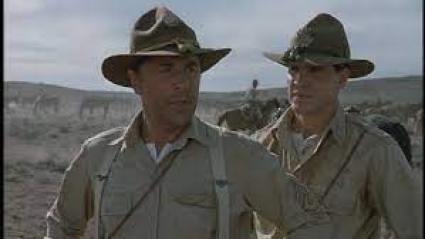
In In Pursuit of Honor the protagonist’s arc doesn’t cooperate with an organic theme because the change seems to occur from the outside in rather than the inside out.
4. There Must Be Consequences in the End of the StoryFor a theme to be a theme, it must mean something. And it won’t mean anything unless that meaning is at stake throughout the story. By the story’s end, which thematic argument wins out should create grave consequences for all of the characters.
In an action story, the conclusion of the theme will often have life-and-death stakes. In a relational story, the relationship will be at stake. In other stories, what is at stake may simply be the characters’ ability to be honest with themselves and maintain inner integrity. Regardless, according to what the plot has so far set up, what happens in the end of the story must matter. Your theme depends upon it.
More than that, what happens must be a natural outgrowth of everything that has happened up to this point. A story that has focused on life-and-death stakes needs to focus on those stakes in the finale, not relational stakes—and vice versa. If your themes are organic, they will be present on every page of your story and nowhere more prominently than in the finale.
How to Write Organic Themes: The stakes in The Magnificent Seven are called out by the antagonist, the bandit Calvera, when he first discovers the gunfighters in “his” village. Half joking, he speaks to the lead gunfighter of his own supposed mercy in leaving the villagers enough money to have hired these gunfighters to fight against him. Calvera chortles, “Sooner or later, you must pay for every good deed!” This will turn out to be prophetic, both for Calvera himself and for all the gunfighters—who are given the choice to leave the villagers in the face of doomed odds but choose to come back anyway. The only way for the importance of this decision to matter is for this choice to come with a heavy cost. And indeed it does as most of the gunfighters are slaughtered.

Organic themes always prove their reality via their honest exploration of consequences, as does The Magnificent Seven, which sees most of its number sacrificing themselves for the village.
How Not to Write Organic Themes: The stakes in In Pursuit of Honor are reiterated throughout the story. First, if the horses fail to reach safety in Canada, they will be massacred. Second, the soldiers are risking court-martial if they are caught and the inglorious end of their careers either way. Third, their live are at risk simply in taking on such a daring mission. Unfortunately, however, the weight of these stakes is never conveyed. Although one sergeant does die, we don’t much care because he was never characterized. Even worse, when the Climax sees the Cavalrymen triumphantly herding the horses into the kindly hands of the Canadian Mounties, all possible consequences for their choices are wiped away. In a massive deus ex machina, it is announced at the last moment that the President has heard of their mission to save the horses and granted them a full pardon—a story beat made all the more egregious by the fact that FDR was never mentioned in the story up to that point.
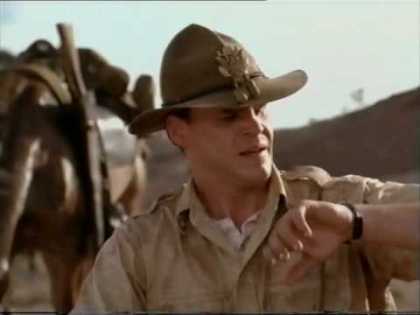
Even had the story managed to build an organic theme up until the ending, In Pursuit of Honor cops out to a deus ex machina that robs all meaning from the characters’ choices and suffering.
***
If there is one simple and non-technical lesson here, it is simply go deep. Organic themes arise from stories that thoroughly and honestly explore the consequences of their own plot events. If that’s not happening, then whatever potential your story’s premise may hold for a strong theme will be wasted. The good news is that any story worth exploring will almost always bring with it the possibility of a compelling theme.
Wordplayers, tell me your opinions! What organic themes are you exploring in your latest story? Tell me in the comments!Click the “Play” button to Listen to Audio Version (or subscribe to the Helping Writers Become Authors podcast in Apple Podcast or Amazon Music).
___
Love Helping Writers Become Authors? You can now become a patron. (Huge thanks to those of you who are already part of my Patreon family!)The post Here Are Two Ways to Write Organic Themes appeared first on Helping Writers Become Authors.
March 13, 2023
Genre Tips: How to Write Horror
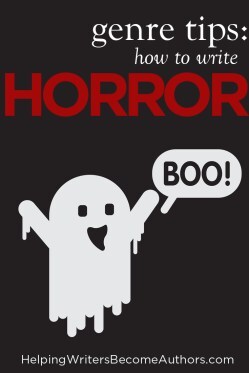 Note From KMW: I’ve been delighted to hear that so many of you have enjoyed the “Genre Tips” we’ve been exploring these past five weeks. Today, I’m happy to share a surprise post to finish off the series! Welcome to “How to Write Horror.”
Note From KMW: I’ve been delighted to hear that so many of you have enjoyed the “Genre Tips” we’ve been exploring these past five weeks. Today, I’m happy to share a surprise post to finish off the series! Welcome to “How to Write Horror.”
As you may remember, I crafted the series around the five major genres to which I felt I could bring value (those being Fantasy, Romance, Historical, Mystery, and Literary). One major genre I did not feel qualified to write about, simply because I don’t read or watch much of it, is Horror. In response to my mentioning this in the series’ opening post, Horror aficionado Oliver Fox stepped up to go deep in a guest post on this popular genre.
Today, I’m happy to share with you a thought-provoking and thorough examination of this archetypal genre.
In the post, Oliver talks about important tips and tricks for structure and theme in Horror, as well as the symbolic “character triad” of the Haunted House, the Average Joe, and the Monster.
Keep reading for more!
***
Horror may be the least understood and most maligned genre. It is usually portrayed as revelry in violence, gore, and nihilism, and thus something immoral—perhaps even wicked. Or horror stories are thought of as loose narratives punctuated by a series of jump-scares. Sadly, these are accurate portrayals of many stories that have become mainstream in the horror genre. However, it’s worth considering whether glorying in the darkest human tendencies is necessary or even desirable in horror.
My aim is to determine the essence of horror and explore it using stories that provoke our deepest fears without relying on our reactions to surprises, deformity, and death. I believe great horror aims for more lingering types of fear brought about by experiences of the Uncanny and the Unknown, unsettling us and filling us with dread. Thus, equipped with a more nuanced understanding of horror, this article will explore how to write horror.
Now that we have a better idea of what isn’t necessary to horror, let’s consider what the genre’s essential qualities are and how to write horror using the Big Three of storytelling as our guides: Character, Plot, and Theme.
3 Tips for How to Write HorrorCharacter Triad in Horror: The Haunted House, The Average Joe, and The MonsterThe Haunted House
In this article, I’m treating the setting as a character, which isn’t unprecedented; the idea of setting as character has existed for a while. Like a human character, a setting that is a character has a past with consequences that linger into the present. Through an understanding of the setting’s past and present, we get hints how it might interact with the characters within—what it might “do” to them in the future.
The archetypal horror setting is the Haunted House. The setting doesn’t have to be a literal house—it could be anything: a derelict research lab, a stranded spaceship, or an arctic research facility. What’s most important are a few key features.
The Haunted House must be:
IsolatedDisempoweringEvoke a sense of Lingering Dread because of some terrible past events that occurred there—although often that past isn’t immediately apparent.The horror setting is haunted by its past, perhaps metaphorically (in that there are still hints and vestiges of said past) or perhaps literally (by something monstrous tethered to it, actively stalking its corridors).
For Example: In the film Alien, there are two Haunted Houses. The first is the planet where the Nostromo’s crew lands to investigate the source of a signal. There, they discover a collection of unsettling tableaux: a crashed spaceship, within it a fossilized humanoid alien, and a room full of large, leathery eggs. Nothing is actively stalking the setting, but the Nostromo’s crew can tell this was the site of some horrific event. While on the planet, one of the crew members foolishly tinkers with the eggs and becomes host to a parasite which injects him with an embryo. Soon the embryo gestates, bursts from the unfortunate crewman, and begins actively haunting the Nostromo, picking off the crew one by one.
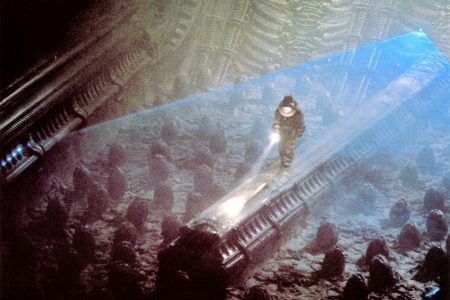
The Average Joe/Jane
In many genres, the protagonist is someone extraordinary, whether in capabilities or because of some special origin and destiny. However, this trope doesn’t work for horror. In horror, the protagonist ought to be exceptional only in a lack of any capabilities or resources. This is to emphasize their vulnerability as they navigate the Haunted House and face the Monster, increasing the audience’s concern for their safety. Think about it: a story about Thor going up against a Japanese ghost girl inspires zero tension, no matter how spooky the ghost is. To build tension, we need to be acutely aware of the protagonist’s helplessness.
For Example: In the book and film Rosemary’s Baby, Rosemary is a young stay-at-home wife pregnant with her first child. Rosemary has recently moved into a new building where she knows no one. Virtually everyone marginalizes and disenfranchises her: her new neighbors gaslight her whenever she raises concerns about strange goings on, her doctor insists she ignore her instincts about her pregnancy, and even her husband abuses her. Rosemary is disempowered in every way imaginable and has no one to turn to when she realizes she and her child are at the center of a cultic conspiracy. With the odds stacked against Rosemary, we can’t help but fear for her safety.
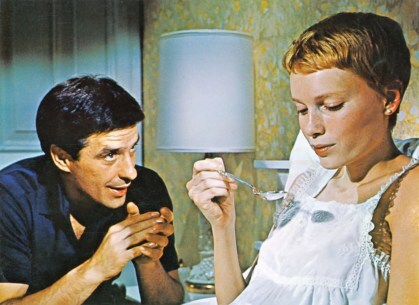
The Monster
The Monster is the central figure in all horror stories. According to horror philosopher Noel Carroll, a horrific monster is anything outside the natural order.
It is unnatural because it is a:
Fusion of opposites (eg., vampires, who are simultaneously dead and alive).Fission. This indicates oddly paired or sequenced elements (e.g., werewolves, who are humans most of the time but can change into creatures capable of indiscriminately murdering loved ones).Formlessness. These are misshapen (even shapeless) creatures, which break down our established categories (e.g., a sentient blob or mist consuming everything in its path).But Monsters can’t be just unnatural; they must also be morally impure deviants. Deviant Monsters willfully upend moral values by indulging in harmful taboos, such as acts of violence toward the self and others. Such moral monsters are the perverse mirror image of a hero. Just as heroes represent an idealized vision of humanity who sacrifice their own desires for the needs of others, deviant monsters are vicious in every way, sacrificing the needs of others for their own desires.
For Example: One film that features a Monster in which all three categories are combined into one terrifying creature is The Thing. The Thing is a fusion of opposites: an alien virus that perfectly replicates the infected host at the cellular level, so the resultant hybrid organism is convinced it is still whatever it was originally… until the dormant virus feels threatened. That leads us to fission. The Thing usually appears as a perfect doppelgänger of the organism it has infected, but if it fears it has been found out, it will rip apart the host and repurpose body parts as weapons or extra limbs so it can escape. Third, when the Thing dismantles its host, the person’s appearance becomes misshapen to the point of formlessness. Finally, the Thing is morally impure because it inflicts violence on its victims at every level of their being by invading their bodies, destroying them, and co-opting their constituent parts to serve its own purposes.
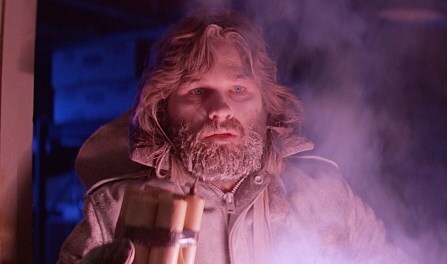
When writing horror, the temptation is to dive headlong into the action, to throw the Average Joe into the Haunted House straight away and cut loose the Monster. However, the audience needs time to connect with the protagonist, to unravel steadily the mystery of the setting’s dreadful past, to wonder what kind of monster lurks just out of sight. That may all sound counterintuitive, but consider this: if you don’t know the characters well enough to care about them, are you going to worry when a Monster stalking them from the shadows of the Haunted House? If we know all the gruesome details about the setting’s past from the get-go, it’s like working a puzzle with detailed instructions on hand; we won’t get the sensation of dawning comprehension—we don’t experience the chilling realization, “Oh, _______ happened in this room. This place was for _______!” If we are familiar with the Monster too early on—its appearance, methods, and intentions—it is demoted to the status of a typical villain.
To create tension, skilled horror writers set up the expectation of something terrible happening while ensuring the audience can’t predict when it will happen. The buildup to a scare is as important as the scare itself. Let the audience do the work of building tension for you during the long, quiet moments by filling these stretches with false threats: moving shadows, deceptive images in mirrored surfaces, background noises, etc.
Okay, so build tension, then let all heck loose and keep it coming nonstop, right? Nope! Just as it is essential for tension to build to a breaking point in horror, so too should we ensure the audience is given time to recuperate and catch their breath before introducing the next scare. Otherwise, you risk exhausting them until they are emotionally spent by the time you reach the final confrontation with the Monster.
For Example: Stephen King’s IT brilliantly shows each aspect of the tension-release cycle in horror. The story opens by introducing each member of the Loser’s Club, giving you time to get to know them enough that you care about their safety. We then see a brief encounter with the monster, IT—just enough that we have some sense of what he’s done, but not to where we fully understand the extent of ITs intent and capabilities. Then we move on to the next member of the Loser’s Club. This cycle occurs for each character, creating emotional peaks and valleys. The setup for a new character’s story functions as the emotional valley for the previous character’s tension-release cycle.


Writing Your Story’s Theme (Amazon affiliate link)
For me, all these elements come together to suggest that horror, at its best, holds up a mirror to the audience, helping them consider a central thematic question: what is monstrous within themselves and how can they overcome that monstrousness?
The horror protagonist is ordinary, as are we, allowing us to empathize with them. They become our avatar. The Haunted House represents self-reflection, a place wherein we feel alienated, isolated, and disempowered because we are alone with ourselves. The Monster is an embodiment of the worst aspects of ourselves, the things we keep hidden from the rest of the world out of shame; these are our darkest desires run amok, haunting our conscience.
If we apply this theory at every level while designing our Horror story, we can create a truly rich narrative. For example:
The Average Joe character is haunted by a deep moral flaw and/or selfish past action (or failure to act) that they find monstrous about themselves.Both the Haunted House and the Monster evoke that flaw, embodying it so the protagonist cannot ignore them.The story climaxes when the Average Joe enters the Haunted House and faces the Monster who embodies their own flaw.The ending tells us something about the destructive nature of the moral flaw the Monster embodies, or at least the danger of waiting too long to face it.For Example: The Twilight Zone episode “The Monsters Are Due on Maple Street” is a masterclass of the horror model described above. Strange things happen in a quiet, isolated suburb, prompting a little boy to draw comparisons between the strange events and a story he’d read about alien invaders. Some of the other citizens buy into the boy’s alien invasion theory and, fueled by old personal grudges, begin accusing one another of being alien monsters. The accusations devolve the situation into an all-out witch-hunt; the citizens of the neighborhood commit atrocities against those they fear are monsters. The theme that unfolds can be described as: “When we ignore our prejudice for too long, that prejudice grows into outright fear, then hatred—a hatred which demonizes others to where we can justify even the most evil actions taken against them until we become something demonic ourselves.” This terrifying premise unfolds with no jump scares and few depictions of violence.

***
Contrary to popular belief, great horror stories are not just exercises in violence, gross-outs, and gore. At their best, they are apt, timely, and frightening social commentaries and self-reflections filtered through the lens of metaphor. True horror might even be the most moral genre, thanks to its uncompromising depiction of monstrous evil as horrifying. I hope you find this article insightful, interesting, and helpful as you write your own horror stories!
Previous Posts in This Series:
How to Write FantasyHow to Write RomanceHow to Write Historical FictionHow to Write MysteryHow to Write Literary FictionWordplayers, tell me your opinions! Have you ever written in the horror genre? What are your thoughts on how to write horror? Tell me in the comments!References and Further Reading
Monsters Within . . . “The Horrific, Moral, and Transcendental” by D. Breyers Monsters Within . . . “Victorian Horror Novels” by J. Cognard-Black Christian Horror: On the Compatibility of a Biblical Worldview and the Horror Genre by M. Duran Supernatural Horror in Literature . by H.P. Lovecraft Horror Protagonists – How Ordinary Characters Make Scarier Games – Extra Credits by J. Portnow The Beast Macabre – What Makes a Monster Scary? – Extra Credits by J. Portnow Shiver with Anticipation – How Horror Games Create Tension Cycles – Extra Credits by J. Portnow Places of Horror – The Secrets of Scary Settings – Extra Credits by J. Portnow The Twilight Zone – What Do We Fear? | Video Essay by Screened Monsters Within . . . “Psychological Horror Films” by E.O. WilliamsThe post Genre Tips: How to Write Horror appeared first on Helping Writers Become Authors.
March 6, 2023
Genre Tips: How to Write Literary Fiction
 What exactly is literary fiction? Although the term often means many different things to different people, the general consensus is that literary fiction encompasses dramatic stories that consciously focus on existential themes and artistic prose. Naturally, these elements can appear in any type of story, so deciding you want to learn how to write literary fiction can be helpful not only in writing stories that specifically fit this category, but in raising the vibration on any type of story.
What exactly is literary fiction? Although the term often means many different things to different people, the general consensus is that literary fiction encompasses dramatic stories that consciously focus on existential themes and artistic prose. Naturally, these elements can appear in any type of story, so deciding you want to learn how to write literary fiction can be helpful not only in writing stories that specifically fit this category, but in raising the vibration on any type of story.
Ironically, the term literary fiction is often used in opposition to the term “genre,” which I guess means we have the “literary genre” and the “genre genre.” (And now that I think about it that way, it cracks me up. #sorrynotsorry :p ) Literary fiction is a somewhat contested term, used by some writers to indicate a “higher level” of writing and by others as a crack at elitism. Back in the day when what is properly considered “genre fiction” was classed only as lowbrow pop fiction for the masses, literary fiction was the domain of the “serious” writer. These days, however, when so many “genre” entries are themselves high art, the borders of what is literary fiction and what is not have become a bit mistier.
It also used to be (and still is to some degree) considered a rule that genre fiction focuses on plot (i.e., events happening to the protagonist), whilst literary fiction focuses more on character and theme (i.e., how the protagonist reacts to events). Although each of these approaches create significantly different reading experiences (both of which are legitimate and wonderful in their own right), this argument between “plot and character” has been largely responsible for creating the dualistic idea that story must be one or the other—and that one must be better than the other. Of course, the truth is story requires both plot and character. You can’t have one without the other. All stories have plot except perhaps the most wildly experimental novels (which, honestly, I would class as a genre of its own).
So if we can’t narrow down the strict definition of literary fiction as fiction that…
focuses on dramaoffers existential themesis artisticemphasizes beautiful prosecrosses over into no other genrevalues character over plot…then how can we determine what is literary fiction—and what is not?
5 Tips for How to Write Literary FictionUnlike genres such as romance and mystery, literary fiction is not defined by its beats. Nor is it strictly a milieu backdrop like fantasy and historical fiction. It can be set anywhere, anytime. It can focus on love stories, on murder investigations, on supernatural evil, on presidential assassinations, on slices of life. It can feature characters who are human, animal, or even inanimate.
It’s kind of like that old saw: “You know it when you see it.” For my money, literary fiction is primarily defined by attitude and perspective. Any story could be told as literary fiction; what makes it so is how it is told.
Although literary fiction contains all the same structural pieces as any other type of story, it is more intent on the journey than the destination. It looks around. It wants to see and observe; it wants to stop and ask questions. Usually, it does so from a slightly distanced perspective. Even if it utilizes a deep POV that puts readers right there in the characters’ heads, what is evoked is the sense of being one step back from the action, observing, commenting, noticing the deeper meaning.
Sound interesting? Then let’s take a quick overview of how to write literary fiction.
Story Structure in Literary Fiction: Understanding How to Intertwine Inner and Outer Conflict
Structuring Your Novel (Amazon affiliate link)
The notion that “literary fiction” is synonymous with “plot-less fiction” is a misconception. What’s true is that literary fiction is not as dependent upon or hemmed in by specific beats as are genres like romance and mystery. However, the basic structural arc underlying a story’s plot becomes all the more important in supporting and unifying the often sprawling and sometimes abstract events and motifs within a literary story.
What’s also true is that the plot in literary fiction is often less concerned with its story’s external conflict (even if it’s rip-roaring) and more concerned with the characters’ internal conflict. You might say literary fiction is more interested in character arc than structure. But (surprise!) that, too, is a false paradigm. Why? Because the mechanics of character arc are inherently structural.
Plot structure can be viewed as the emergent of character arc. The entire arc of what we recognize as story is merely the externalized structure of the natural and inevitable pattern of human transformation. In short, if a literary story creates a magnificent character arc, you can be sure it is also well structured.
The structural beats in any story will tell you what it is about. In a literary story, those beats will focus intently on the inner conflict and evolution of the characters. Even if you’re writing your story with a relatively loose focus on structure, just double-checking that the ten major structural moments are all focused on your character’s internal journey will help you ensure both plot and character are powerfully aligned.
Those structural elements are:
HookInciting EventFirst Plot PointFirst Pinch PointMidpoint (Second Plot Point)Second Pinch PointThird Plot PointClimaxClimactic MomentResolutionFor Example: F. Scott Fitzgerald’s beloved classic The Great Gatsby is a pitch-perfect example of how external conflict (of which there is plenty, as Gatsby jets around NYC, causing and enduring all manner of havoc) can play out primarily through the lens of a character’s internal conflict (in this instance, through the observations of narrator Nick Carraway, who stands at a remove from the relational machinations of Gatsby and the other characters and who undergoes a Disillusionment Arc as a result).
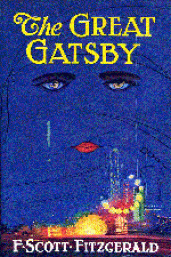
The Great Gatsby by F. Scott Fitzgerald (affiliate link)
Character in Literary Fiction: Backstory As the Origin of Motivation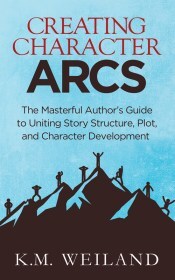
Creating Character Arcs (Amazon affiliate link)
Genre fiction asks, “What will happen?” Literary fiction, however, is often more concerned with, “What did happen?” Its most urgent question is, “Why?”
Although sometimes this exploration may offer an external plot that is intent on uncovering revelations new to the main characters, it just as often focuses on diving deep into an exploration of the characters’ own pasts. Memories, feelings, events, old hurts, lost loves, delusions, and dreams—all are excavated and reexamined in the characters’ search for meaning.
Backstory and its motivating “Ghosts” are important catalysts for the character arc in any type of story, but in literary fiction the uncovering of how the past has affected the future is often of primary importance. Alternate timelines are a popular device in literary fiction, allowing backstory to be explored side by side with the characters’ current dilemmas. Even when a story is told in a linear fashion, it is understood that much of what we see is context for a final realization.
This emphasis on the causal effects within a character’s personal development doesn’t necessarily require a huge or shocking event in the character’s backstory. Rather, the emphasis is on the why of how characters ended up where they did or are making the choices they are currently faced with.
For Example: Toni Morrison’s finely-wrought Beloved drops a horrifyingly shocking backstory bomb halfway through when it reveals what happened to main character Sethe’s “almost crawling” baby girl. In a different type of story, this revelation might have been played for all the drama it was worth. In this quiet exploration of the effects of slavery, the revelation is equally quiet, made all the more horrifying by its unflinching deliberateness in examining the reasons for and effects of Sethe’s choices. Although it is a huge plot moment, it is chiefly utilized as an exploration of character.
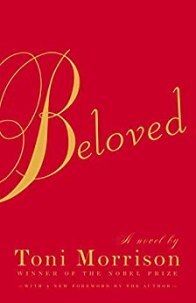
Beloved by Toni Morrison (affiliate link)
Theme in Literary Fiction: Theme as Message vs. Theme as Question
Writing Your Story’s Theme (Amazon affiliate link)
Although theme will emerge from any well-constructed plot and/or character arc, literary fiction is noted for its conscious exploration and execution of its themes. Heavy-handed themes that present themselves as “answers” to their readers are not welcome in any type of story, and this becomes all the more true in a literary story that very likely will be exploring its themes “on purpose.”
For example, a genre action story about a brave naval admiral may express themes of courage, duty, and honor merely through the external actions and outcomes in the plot. A literary story will go deeper in examining the character’s interiority, as he struggles literally with these questions in his own mind.
Ironically, this means literary fiction can easily come across as far more moralistic and “on the nose” than most genre fiction. The key to any successful exploration of theme is focusing less on the answers or “lessons” and more on the questions that are inherent within the character’s struggles. There is never any need to spell out a thematic premise for audiences; the outcome of the plot events will always present the author’s thesis on how certain causes lead to certain effects.
Particularly in literary fiction, which can sometimes be more open-ended than other types of stories, thematic emphasis should be less on proving a certain point and more on an honest exploration of how certain thematic questions affect the characters’ outlooks and choices. Arguably more than in any other genre, allowing characters to choose wrong and then showing the effects of those choices in the end can be especially powerful in literary fiction.
For Example: The Remains of Day by Kazuo Ishiguro utilizes flashbacks to explore the choices of its protagonist, lifetime butler Stevens, who chose to remain loyal to his Nazi-sympathizing employer, not because he agreed with the politics but because he was so identified with his work. This raises questions he must explore in his present as he seeks to reunite with a woman he might have married, had he made different choices.
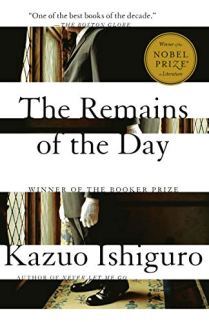
The Remains of Day by Kazuo Ishiguro (affiliate link)
Scene Structure in Literary Fiction: Controlling Pacing via Action and ReactionThat certain “attitude” of literary fiction, its focus on the interiority of is characters, and its leisurely pacing can be tricky to define, much less evoke in one’s own writing. One of the best hacks can be found in scene structure.
Scenes can be divided into two basic parts: action and reaction. These two parts are sometimes referred to as “scene” (action) and “sequel” (reaction), which can then be divided down further into three parts apiece:
Goal (character wants something)Conflict (an obstacle is introduced)Outcome (the initial goal is either obstructed or leads to a new goal)Reaction (character reacts emotionally to the previous outcome)Dilemma (previous outcome has created a new problem)Decision (character decides upon new goal)Stories that emphasize external action usually put more weight upon the action half of the scene. In these stories, sometimes the reaction half may be summarized rather than dramatized to allow the narrative to return to the action as quickly as possible.
Literary stories, however, flip the script. In literary fiction, the reaction or “sequel” is usually more markedly emphasized. The action still happens, just as in any story. Indeed, literary stories can be just as full of war-time explosions, psychopathic murderers, and passionate trysts in the rain as any other type of story. The difference is that the action portion of the scene will not always be heavily dramatized. In some instances, the action may not be dramatized in the story’s “real time” at all, but rather looked back upon from the character’s reaction phase.
For Example: I first noticed the use of this technique when reading Kathryn Magendie’s Sweetie, about a timid young girl who befriends a feral mountain child. The book’s leisurely emphasis of sequels over scenes takes nothing away from its potency or urgency.
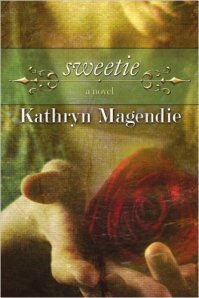
Sweetie by Kathryn Magendie (affiliate link)
Prose in Literary Fiction: When Beauty Is Truth and Truth Is BeautyThose who love to read literary fiction or want to write it often return to the genre again and again simply for the beautiful artistry of its prose. Although beautiful prose can be found in any genre, it is a necessity in literary fiction. Not only does it help pull readers into a story in which it’s possible that, strictly speaking, not much is happening, it is also an important tool for deepening the story’s thematic exploration.
Readers of literary fiction expect more from the genre than just a good story (although they expect that too). They expect a kind of truth from the prose that is found nowhere more strongly than in poetry. Literary novels are, in their way, like beautiful prose poems. Their word choices are exquisite—every syllable chosen not just for its efficacy, but for its symbolic effect. More than that, the prose creates a mirror that is held up to both our darkest and most beautiful parts. Those mirrors are only clear when the wordcraft has been honed to communicate not just to the readers’ conscious mind, but to the parts of them that exist beyond the words.
For Example: One of the most gorgeous books ever written, The Night Circus by Erin Morgenstern evokes its fantasy worldscape through prose that is, as one reviewer put it, “seductive and mysterious.” This is also a wonderful example of a “genre” story that crosses over into literary fiction.

The Night Circus by Erin Morgenstern (affiliate link)
***
More than anything else, literary fiction is a style. It evokes an effect that allows it to explore life itself with a magnifying glass—to go deep in observing the tiniest details and the most tempestuous human experiences. It is a beautiful genre that can be melded with almost any other style to create unforgettable stories that appeal to many different types of readers.
Stay Tuned: Next week, guest poster Oliver Fox will close out the series by talking about Horror!
Previous Posts in This Series:
How to Write FantasyHow to Write RomanceHow to Write Historical FictionHow to Write MysteryWordplayers, tell me your opinions! What are your thoughts on how to write literary fiction? Tell me in the comments!Click the “Play” button to Listen to Audio Version (or subscribe to the Helping Writers Become Authors podcast in Apple Podcast or Amazon Music).
___
Love Helping Writers Become Authors? You can now become a patron. (Huge thanks to those of you who are already part of my Patreon family!)The post Genre Tips: How to Write Literary Fiction appeared first on Helping Writers Become Authors.
February 27, 2023
Genre Tips: How to Write Mystery
 Following closely on the heels of romance, mystery is one of the most popular fiction genres of all time. At its simplest, the genre is a puzzle for audiences and characters to figure out together. At its most complex, mystery offers a deep-dive into humanity’s most pressing existential questions and threats. Populated by manifold subgenres, mystery offers room for many expressions, but its intelligent and experienced audience expects specific details in its execution. Learning how to write mystery stories is, as it turns out, about so much more than “just the facts, ma’am.”
Following closely on the heels of romance, mystery is one of the most popular fiction genres of all time. At its simplest, the genre is a puzzle for audiences and characters to figure out together. At its most complex, mystery offers a deep-dive into humanity’s most pressing existential questions and threats. Populated by manifold subgenres, mystery offers room for many expressions, but its intelligent and experienced audience expects specific details in its execution. Learning how to write mystery stories is, as it turns out, about so much more than “just the facts, ma’am.”
Mystery can be divided into several categories, including but not limited to:
Thriller (focusing on dangerous stakes for the characters caught up in needing to solve the mystery, such as The Fugitive)
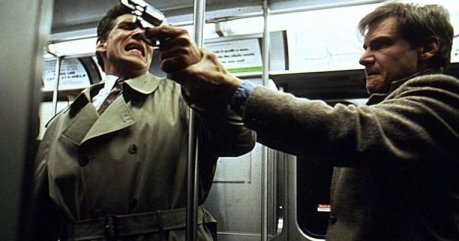
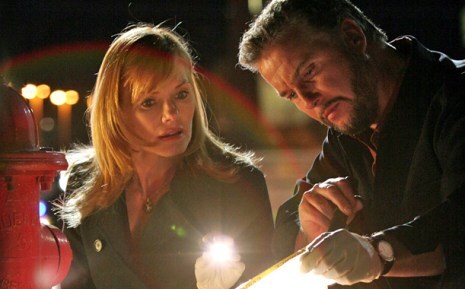

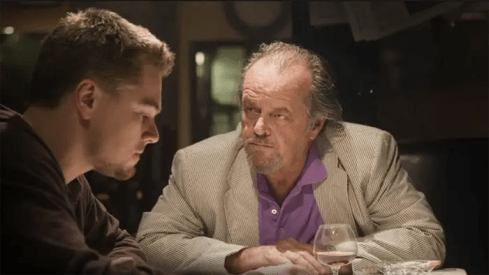
There are many other subgenres, and many of these can overlap or be included in other subgenres that are primarily focused on evoking a certain milieu or atmosphere, such as:
Cozy (focusing on a “cozy” setting, low-key stakes, little gore or violence, and usually a citizen “detective”, such as Miss Marple)
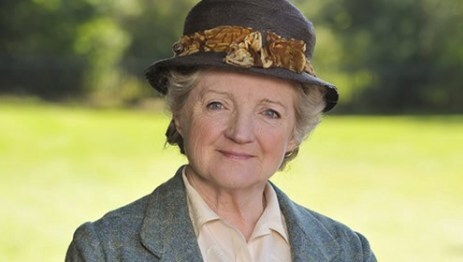
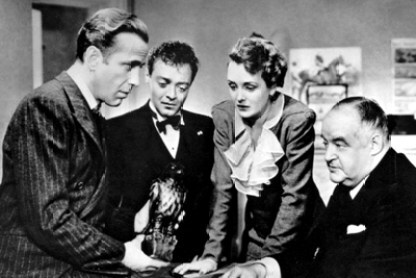
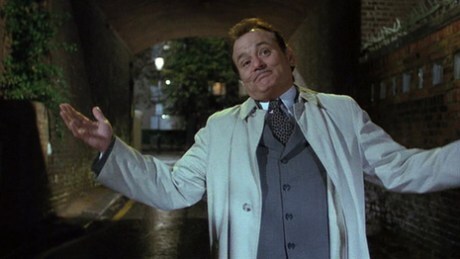
Like romance, mystery often crops up as a subplot within stories that would primarily be classed as other genres. Or the story may be set entirely within the milieu of a different genre, even though it still follows the mystery structure. For example, mysteries may often take place in a fantasy setting, as with Jim Butcher’s Dresden Files series or Magic Lost, Trouble Found by Lisa Shearin.

Storm Front by Jim Butcher and Magic Lost, Magic Found by Lisa Shearin (affiliate links)
Also popular are historical mysteries, such as Miss Scarlet and the Duke.
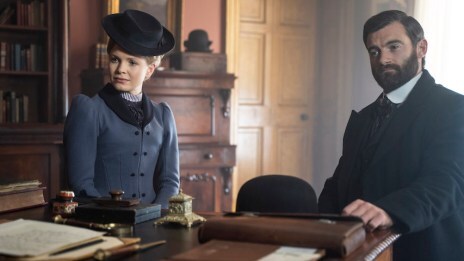
And we also see romantic thrillers and romantic suspense.
5 Tips for How to Write MysteryReaders choose mysteries when wanting a puzzle to tease their brains. The best mysteries are those that pull off that most impressive trick of all: outsmarting their readers while playing fair. Mystery readers are a smart crowd, not only intelligent in their own right, but extremely familiar with all the tropes and tricks a mystery writer might think to pull. So in the interest of outsmarting readers, let’s talk about how to write mystery.
Foreshadowing: Mystery Is All About Setup and PayoffWhen you think about it, mystery is really nothing more than foreshadowing. Or rather, a good mystery is all about foreshadowing. A little suspense and a big reveal in the end does not make a mystery. Although readers want to be fooled, they also want a fair shot at solving the case. A true mystery is one that lays out all the clues for its readers, hiding little to nothing of what the detective character learns.
But how can you show readers all the clues and expect them not to figure out what’s going on? No doubt you’ve done your own fair share of figuring out whodunit the moment the culprit shows up on screen. Particularly in short-form fiction, such as serial TV shows, it can be difficult for writers to cram in the necessary foreshadowing without being too obvious. In some instances, writers must convey murder, means, and motive all in 45 minutes (while probably sharing time with a personal subplot for at least one of the regular characters).
The true skill of a mystery master is showcased nowhere more obviously than in foreshadowing. Foreshadowing is made up of two parts: setup and payoff—the planting of the clue and the eventual deciphering of the clue. Somewhere in between, however, is where the real magic happens, thanks to another crucial piece: misdirection.
However, audiences these days are so smart they often recognize misdirection the minute a story puts more than casual emphasis on a piece. Instead of being distracted from the truth, they immediately think, Ah, well, that obviously isn’t the culprit! (Or, if the culprit’s identity isn’t the mystery, That can’t really be how it happened or why it happened!)
Finding exactly the right balance between foreshadowing and misdirection is literally an artform. One of the best secrets is simply that of getting your audience emotionally involved in the misdirection. Make it real. Build it from the inside-out—whether it’s just a small detail or a fleshed-out subplot. The secret to any successful plot twist (and really that’s all mystery is) is making sure readers are so satisfied with the twist that even if they guessed it ahead of time, they’d still enjoy getting there just as much. More than that, when you have an audience’s emotions involved, they are that much less likely to think about every little detail you present.
For Example: In State of Play, the real culprit is always the chief suspect, but the way the story weaves in the emotions of the protagonist, investigative journalist Cal McAffrey, and gets the audience to identify with his motives for seeing the story a certain way, prevents the unfolding of the mystery from feeling on-the-nose or rote, whether or not audiences guess the truth before Cal does.
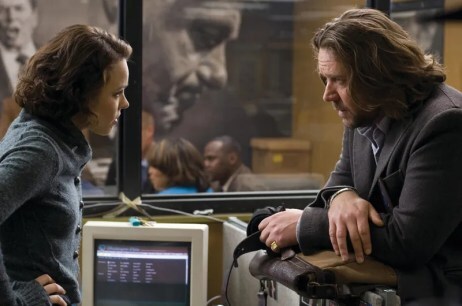

Structuring Your Novel (Amazon affiliate link)
The mystery genre follows classic structure, but uses plot beats to grip readers with the occasional revelation and to deepen the mystery. You can find many genre-specific resources that break down expected mystery beats much more specifically, but here is a quick rundown:
Hook: Mysteries sometimes open immediately with the dead body or whatever other crime is to be explored, but may also open with a character-centric scene in which the protagonist is introduced in a way that frames the larger stakes and theme with the character’s personal issues.
Inciting Event: If the crime hasn’t already taken place, this is where it happens. If it did take place earlier, this is usually where the detective character will become aware of the case in some way—either by being assigned to it in a professional capacity or by being drawn into it for personal reasons (e.g., she is targeted or the victim was a friend).
First Plot Point: Symbolically, this is the Door of No Return. In a mystery, this means the stakes become personal and/or irrevocable for the protagonist. In some stories, this could be where the protagonist decides to keep investigating even after being warned off. In other stories, the killer might strike again, sometimes even striking very close to home for the protagonist. Either way, a major clue will be introduced.
First Pinch Point: Pinch points emphasize the antagonistic force’s threat and what is at stake for the main characters. In mysteries in which the killer is aware of the protagonist, this beat might include an attempt from the killer to warn the protagonist off the case. In other stories, the threat might be more existential, either because something is discovered that causes the protagonist to question himself or his own motives or methods, or because some horrible new clue escalates the stakes.
Midpoint: The Midpoint, or Second Plot Point, is always a Moment of Truth. In a mystery, this revelation can be quite literal. The protagonist discovers the biggest clue yet, something that completely changes the case. The protagonist’s understanding of this Truth is not yet complete, however; the Truth is still obscured by things the protagonist does not understand, both within the plot and the theme.
Second Pinch Point: The stakes ramp up still more. If the story includes personal stakes for the protagonist (e.g., her own safety, the safety of her loved ones, professional integrity, etc.), then those will be emphasized here. In stories with a more distant perspective, in which the protagonist is operating mostly on a professional level, the stakes will be primarily about the mystery: something happens that obstructs the investigation or seems to put the culprit out of reach.
Third Plot Point: Traditionally, this turning point into the Third Act is the moment when “All Is Lost.” Even relatively low-key mysteries may see the Third Plot Point turning them into comparatively dark territory (e.g., the protagonist or someone important is kidnapped). Often, another crime will be committed here, one just as dramatic or more so than the original crime. The detective will have personal doubts about being able to successfully solve the mystery. However, the events here will provide the clues necessary for the protagonist to find the culprit in subsequent scenes.
Climax: The protagonist will identify and probably come face to face with the culprit. In some stories, this can be quite exciting and violent. In others, it can unwind in the classic scene in which the detective gathers all the suspects into the same room and explains his investigation. In other stories, the actual apprehension of the culprit can be relatively low-key.
Resolution: If the story opened with a frame of the protagonist’s personal life, the Resolution will bring that full circle. If not, there may be a scene in which the victims of the crime are afforded a cathartic moment.
For Example: To see structural breakdowns of various mysteries, check out the Mystery Books and Mystery Movies sections in the Story Structure Database.
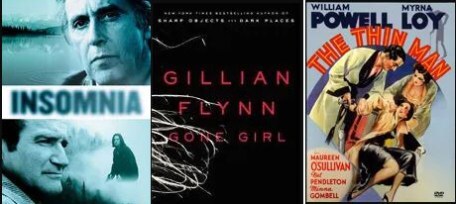
Learn how to write mystery by studying popular books and movies in the genre.
Theme in Mystery: Justice, Passion, and Death
Writing Your Story’s Theme (Amazon affiliate link)
Like all specific genres, mystery offers up its own inherent themes. Because mysteries are ultimately about figuring out a puzzle and seeing beyond the obvious, perspective is often a major theme (as John Truby notes in the introduction to his new book The Anatomy of Genres). Justice is another ubiquitous theme.
If the story features a murder or threat to life, then themes of death are often inevitable. Particularly in mysteries that deal realistically with murder and with the professions that both commit murders and “clean up” after them, the opportunity is there to go deep with existential questions about the truths of life and death and the ambivalent nature of man.
Passion, greed, and any number of other possible motivations for committing a crime can also be explored. Understanding the character arc of not just the protagonist, but also the culprit and the victim can give you solid ideas of integral themes you can explore in your own mystery.
For Example: Dennis Lehane’s Mystic River goes deep in exploring themes of friendship, loyalty, and guilt, in a story about three childhood friends—the father of a murdered daughter, the investigating cop, and the suspect who was himself the victim of a horrific crime when he was young.
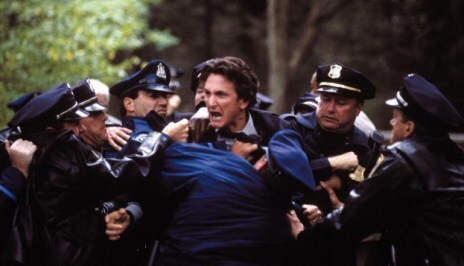
Although the puzzle is the point in a mystery story, it shouldn’t be the story. What audiences truly want from the experience of a mystery story is the opportunity to experience how realistic and entertaining characters engage with the puzzle, its catalyst, and its consequences.
For my money, the most important rule of thumb for how to write mystery is simple: the characters should be able to stand without the mystery.
In other words, your characters should be so interesting audiences would want to engage with them even if the mystery turns out to be easily solvable. This doesn’t mean the mystery should be relegated to a subplot in your characters’ personal lives. But it does mean the characters and their development should be strong enough to grip readers. Whether your story is funny and entertaining or dark and fascinating, readers should be hooked by your characters much more than the twists and turns of your foreshadowing’s setups and payoffs.
For Example: The recent Netflix romp Glass Onion dazzles audiences with interesting characters and entertaining scenarios that keep their attention regardless of how quickly they identify the true culprit.

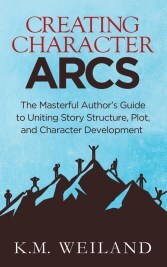
Creating Character Arcs (Amazon affiliate link)
A common question I receive about character arcs is, “What kind of character arc does [names specific detective character] have?” Usually in these instances, the confusion arises because the character in question isn’t arcing. This is because Flat Arcs are extremely common in the mystery genre.
However, this does not mean the story has no arc. A Flat Arc indicates a character who has already integrated and therefore acts upon the story’s primary Truth—and who impacts the world and characters around her via that Truth. Strictly speaking, this will be a thematic Truth (e.g., “justice is important but not always clear cut”). However, in mysteries that don’t go deep with their thematic exploration, this Truth might be conveyed simply in that the Flat-Arc protagonist has the strongest moral compass of anyone within the story.
Writing a mystery with a Flat-Arc protagonist is popular because it allows the story to focus most of its attention on the complications of the plot. However, it’s also entirely possible a mystery may feature a Change Arc, in which the protagonist’s personal view of the world alters dramatically by the end of the story. This might be a Positive Change Arc, in which the protagonist moves out of a more limited or “Lie-based” perspective into a more expansive Truth. Or it might be a Negative Change Arc, in which the protagonist moves into an even more constrained and limiting perspective of the world.
For Example: In Sir Terry Pratchett’s mystery-fantasy Feet of Clay, forthright police investigator Captain Carrot’s steadfast Flat-Arc belief in the rights of all sentient beings not only allows him to solve the mystery but to positively impact the prejudices of others about the golems who everyone believes are mindless killers.
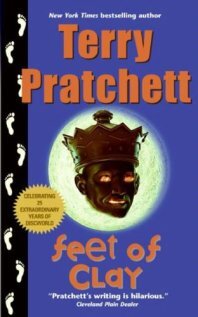
Feet of Clay by Terry Pratchett (affiliate link)
***
In a way, all novels are mysteries, since the primary question all fiction wants readers to ask is, “What’s gonna happen?” The mystery genre takes it all up a notch by leading audiences on an intricate dance of clues, misdirection, and ultimately a deep exploration of the human psyche.
Stay Tuned: Next week, we’ll talk about Literary Fiction!
Previous Posts in This Series:
How to Write FantasyHow to Write RomanceHow to Write Historical FictionWordplayers, tell me your opinions! Have you ever written in the mystery genre? What are your thoughts on how to write mystery? Tell me in the comments!Click the “Play” button to Listen to Audio Version (or subscribe to the Helping Writers Become Authors podcast in Apple Podcast or Amazon Music).
___
Love Helping Writers Become Authors? You can now become a patron. (Huge thanks to those of you who are already part of my Patreon family!)The post Genre Tips: How to Write Mystery appeared first on Helping Writers Become Authors.




